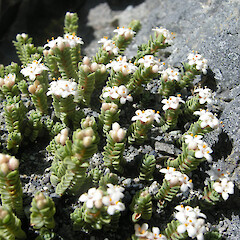Pimelea prostrata subsp. prostrata
Common name
pinātoro, New Zealand daphne, Strathmore weed
Synonyms
P. laevigata Sol. ex Gaertn pro parte; P. prostrata f. parvifolia Allan
Family
Thymelaeaceae
Flora category
Vascular – Native
Endemic taxon
Yes
Endemic genus
No
Endemic family
No
Structural class
Trees & Shrubs - Dicotyledons
Chromosome number
2n = 36, 72, 90
Current conservation status
The conservation status of all known New Zealand vascular plant taxa at the rank of species and below were reassessed in 2017 using the New Zealand Threat Classification System (NZTCS) – more information about this can be found on the NZTCS website. This report includes a statistical summary and brief notes on changes since 2012 and replaces all previous NZTCS lists for vascular plants.
Please note, threat classifications are often suggested by authors when publications fall between NZTCS assessment periods – an interim threat classification status has not been assessed by the NZTCS panel.
- Conservation status of New Zealand indigenous vascular plants, 2017 . 2018. Peter J. de Lange, Jeremy R. Rolfe, John W. Barkla, Shannel P. Courtney, Paul D. Champion, Leon R. Perrie, Sarah M. Beadel, Kerry A. Ford, Ilse Breitwieser, Ines Schönberger, Rowan Hindmarsh-Walls, Peter B. Heenan and Kate Ladley. Department of Conservation. Source: NZTCS and licensed by DOC for reuse under the Creative Commons Attribution 4.0 International licence.
2017 | Not Threatened
Previous conservation statuses
2012 | Not Threatened
2009 | Not Threatened
2004 | Not Threatened
Brief description
Low growing shrub with sparsely hairy branches to 300mm long bearing pairs of blue-green narrow leaves that which join the stem at a small ridge, hairy white flowers and white fruit inhabiting open sites south from near Auckland. Leaves 3-6mm long by 1.5-4mm wide, tip rounded.
Distribution
Endemic. North Island: South Auckland, Taranaki, Gisborne, Hawke’s Bay, eastern Wairarapa, and near Wellington. South Island: Marlborough, Nelson, Westland, Canterbury, Otago, Southland
Habitat
Coastal to montane. In open sites, such as coastal gravel, sand dunes, and mudstone cliffs; on ultramafic rock, mudstone, sandstone, marble, limestone, gravel river floodplains; vegetated places, in open scrub, low grassland, Schoenus marsh, Sphagnum bog, around tarn margins.
Detailed description
A small shrub; stems prostrate, often thin and flexible, creeping on open areas or in low vegetation, pendent on banks, cliffs, up to 300 mm long. Stems may be partially buried on sandy substrates; adventitious roots may develop on these, or on stems in moist habitats. Branching sympodial and lateral. Branchlets uniformly yellowish-brown to brown, usually smooth but sometimes muricate, glabrous except in leaf axils and on receptacles, or sparsely to moderately clad in short, silky hair. Internodes 1–4 mm long. Older stems grey-brown to dark grey. Node buttresses light to medium brown, occupying part or all of the internode; occasionally prominent on leafless branches. Leaves close (exposed or drier sites) or distant (shaded sites), patent, on short red petioles. Lamina glaucous, often red-margined, usually 3–6 × 1.5–4 mm, thin, elliptic to broad-elliptic, flat, tip obtuse. Inflorescences 5–8-flowered, terminal on branchlets. Involucral bracts to 5.6 × 4.2 mm. Flowers relatively sparsely hairy outside, inside hairless, on very short pedicels (0.2 mm). Female tube 2.5 mm long, ovary portion red, 2 mm; calyx lobes 1.2 × 1.2 mm; h tube 4.8 mm long, ovary portion 2 mm; calyx lobes 2 × 1.5 mm. Ovary moderately hairy at summit. Fruits broad ovoid to globose, fleshy, white, opaque 4.2 × 2.8 mm. Seeds narrow-ovoid 2.5 × 1.5 mm, crest very thin.
Similar taxa
Plants of the Pimelea prostrata complex are distinguished by the prostrate to decumbent growth habit; by the glabrous to sparse or moderate hair covering on young stem internodes and by the thin and pliable, completely glabrous leaves with stomata clearly visible on both leaf surfaces. Pimelea prostrata subsp. prostrata is distinguished from subsp. seismica, subsp. thermalis, subsp. ventosa and subsp. vulcanica by the node buttresses elongate to covering the entire internode length; glabrous to moderately hairy young stems, and by the flat leaves with obtuse leaf -tips.
Flowering
September - May
Flower colours
Red/Pink, White
Fruiting
October - July
Propagation technique
Easily grown from semi-hardwood cuttings and rooted pieces. Seed is difficult to germinate. Best grown in a well drained soil in full sun. An excellent plant for the rockery.
Etymology
pimelea: Pimeleoides means “resembling Pimelea’’, a genus in the family Thymelaeaceae (Greek, -oides = resembling, like).
prostrata: Prostrate
Attribution
Description from: Burrows (2008).
References and further reading
Burrows, C.J. 2009: Genus Pimelea (Thymelaeaceae) in New Zealand 2. The endemic Pimelea prostrata and Pimelea urvilliana species complexes. New Zealand Journal of Botany 47: 163–229




